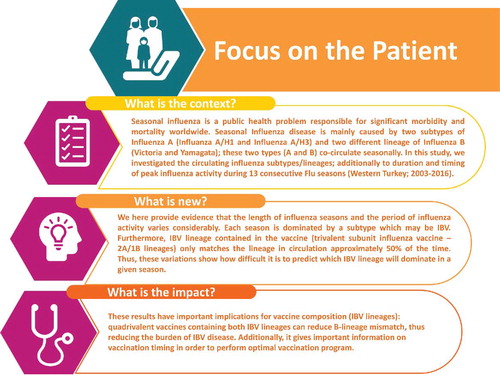Figures & data
Figure 1. Numbers of specimens tested each season (excluding the pandemic year [2009–2010]) and percentages positive for influenza.
![Figure 1. Numbers of specimens tested each season (excluding the pandemic year [2009–2010]) and percentages positive for influenza.](/cms/asset/3d6c13ab-2911-413a-af7f-0a49380581ec/khvi_a_1452577_f0001_b.gif)
Figure 2. Pathogen distribution, by season and overall (excluding the pandemic year [2009–2010]). *A/H1N1 (2003–2009) or A/H1N1/pdm09 (2010–2016). IBV, influenza B virus.
![Figure 2. Pathogen distribution, by season and overall (excluding the pandemic year [2009–2010]). *A/H1N1 (2003–2009) or A/H1N1/pdm09 (2010–2016). IBV, influenza B virus.](/cms/asset/ad0f4014-349d-467a-9002-bd1a3f4d49a7/khvi_a_1452577_f0002_b.gif)
Figure 3. IBV circulation by lineage in Turkey during 2005–2016 (excluding the pandemic year [2009–2010]), by season and overall; and the proportions of IBV specimens tested that matched and mismatched the vaccine IBV lineage. IBV, influenza B virus; V, Victoria; Y, Yamagata.
![Figure 3. IBV circulation by lineage in Turkey during 2005–2016 (excluding the pandemic year [2009–2010]), by season and overall; and the proportions of IBV specimens tested that matched and mismatched the vaccine IBV lineage. IBV, influenza B virus; V, Victoria; Y, Yamagata.](/cms/asset/6b9cf795-5e51-4b17-9217-acf02f2775c4/khvi_a_1452577_f0003_b.gif)
Figure 4. Percentages of all positive specimens (IAV and IBV) estimated* to mismatch the vaccine due to IBV lineage mismatch during 2005–2016 (excluding the pandemic season [2009–2010]). *Based on a subset of IBV samples in which lineage was determined. IAV, influenza A; IBV, influenza B virus.
![Figure 4. Percentages of all positive specimens (IAV and IBV) estimated* to mismatch the vaccine due to IBV lineage mismatch during 2005–2016 (excluding the pandemic season [2009–2010]). *Based on a subset of IBV samples in which lineage was determined. IAV, influenza A; IBV, influenza B virus.](/cms/asset/129a6fc6-0f17-44e2-ae84-9e65433b3e17/khvi_a_1452577_f0004_b.gif)
Figure 5. Timing of the influenza activity periods in Turkey (excluding the pandemic year [2009–2010]). Please note that in years with a week 53, these cases were included in week 52. Please also note the varying y-axis scales by season. *A/H1N1 (2003–2009) or A/H1N1/pdm09 (2010–2016). IBV, influenza B virus.
![Figure 5. Timing of the influenza activity periods in Turkey (excluding the pandemic year [2009–2010]). Please note that in years with a week 53, these cases were included in week 52. Please also note the varying y-axis scales by season. *A/H1N1 (2003–2009) or A/H1N1/pdm09 (2010–2016). IBV, influenza B virus.](/cms/asset/9fd750b3-6a06-41e5-94b0-a7eb69494139/khvi_a_1452577_f0005_b.gif)
Figure S1. Changes in the start of influenza activity in Turkey (excluding the pandemic year [2009–2010]). The dotted line is an Excel “linear trendline”.
![Figure S1. Changes in the start of influenza activity in Turkey (excluding the pandemic year [2009–2010]). The dotted line is an Excel “linear trendline”.](/cms/asset/c2e8904b-792f-48e2-a6b6-adf2e8e7fc70/khvi_a_1452577_uf0001_b.gif)
Figure S2. Comparison of the estimated* pathogen splits in the current study (sentinel surveillance in western Turkey) and Altas et al.1 (sentinel and non-sentinel surveillance in eastern Turkey) during the years common to both studies.
*Based on subsets of influenza B samples in which lineage was determined.

Table S1. Dominant (≥90%) antigenic types of IAV in the vaccine and in circulation in Turkey (2003–2016).
Table S2. Antigenic types/lineages of IBV in the vaccine and in circulation in Turkey (2004–2016).

